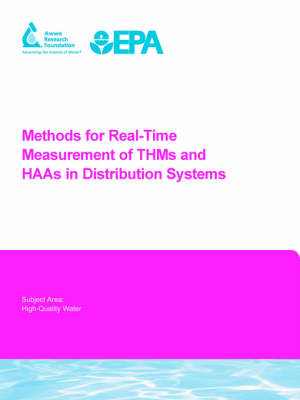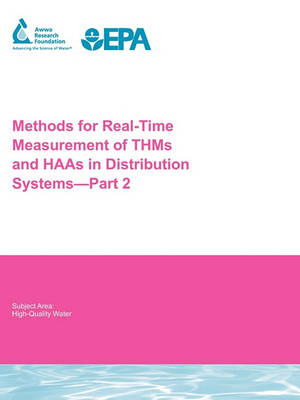Water Research Foundation Report
2 total works
Analytical methods are needed for on-line monitoring to improve understanding of variations in trihalomethanes (THMs) and haloacetic acids (HAAs) concentrations in treatment plants and drinking water distribution systems. The monitoring data will increase understanding of how peak THMs and HAAs formation events occur and when they do not occur, allowing operators to adjust treatment processes accordingly at the plant and in the distribution system. This project is the first of two phases. The goal of the first phase of this project was to conduct an extensive survey of the literature to evaluate which existing analytical methods may be adapted for real-time monitoring of THMs and HAAs in drinking water distribution systems. THMs and HAAs are both disinfection by-products (DBPs) of water chlorination. They are very different in their chemical structures and properties. The THMs are non-polar and volatile. The HAAs are polar and non-volatile. These differences have significant implications in their analytical chemistry applied to drinking water-particularly the sampling-sample preparation step. The concentrations of THMs can be determined using gas chromatography. The major advantage of gas chromatography is its simplicity. The analysis of the HAAs using gas chromatography is more complicated. To be analyzed by gas chromatography, HAAs must be derivitized, thus complicating analysis. The approach of this research is to explore alternative methods that might be adapted for real-time monitoring of THMs and HAAs in water distribution systems. The literature provides much information pertaining to the analysis of THMs and HAAs in drinking water. The goal was to collect data about the operating parameters used in the methods to aid in evaluating the adaptability for real-time monitoring in drinking water. These methods include a wide array of methodologies ranging from simple colorimetric spot tests to more complex LC-MS methods and beyond. A searchable electronic database is included with the final report. This database includes references to all THMs and HAAs papers reviewed to date. Several methods are summarized in the final report for the first phase of this project. These summaries provide information about expected method detection limits, accuracy and precision estimates, details about each method, instruments used, approximate price of instrument and cost of analysis, the sample preparation time, sample analysis times, and the ability to automate the methodology. Additional information about the methods is provided, including lists of the common commercially available GC columns, lists of the common internal and surrogate standards used, and lists of the common HPLC/IC columns. Several options are presented that describe possibilities for automating THM and HAAs analysis for real-time monitoring in distribution systems.The practical benefits of the proposed research are the development of improved capabilities for monitoring THMs and HAAs in drinking water. These methods will provide data for operators that will help them better understand the temporal behavior of the THMs and HAAs at the treatment plant and in the distribution system. The methods that are developed will be simple, relatively inexpensive, and automated. If feasible, the methods will be based upon the well-documented and understood USEPA Methods for THMs and HAAs in drinking water.Originally published by AwwaRF for its subscribers in 2004. This publication can be purchased and downloaded via Pay Per View on Water Intelligence Online - click on the Pay Per View icon below
Methods for Real-Time Measurement of THMs and HAAs in Distribution Systems - Part 2
by G. Emmert, Melanie Brown, P. Simone, Gija Geme, and Gang Cao
Published 1 November 2007
Chlorine, typically applied as gaseous chlorine, sodium hypochlorite, or calcium hypochlorite, is a safe and economical water disinfectant and has been used with great success for over a century. Unfortunately, water chlorination results in the formation of halogenated disinfection by-products (DBPs), including trihalomethanes (THMs) and haloacetic acids (HAAs). Maximum contaminant levels (MCL) have been established by the USEPA for drinking water due to the possible adverse health effects from ingestion of THMs and HAAs.
The current MCLs for total THMs and total HAAs in drinking water are 0.080 mg/L and 0.060 mg/L, respectively. Future regulations might lower the MCL for these DBPs, requiring plant operators to minimize total THMs and total HAAs concentrations in drinking water. To accomplish these goals, analytical methods are needed that will provide monitoring data in real-time or near real-time.
The overall goal of this research was to develop chemical analyzers and associated analytical methods for online monitoring of THM and HAA concentrations directly from drinking water distribution systems. The project has led to the development of several alternative analyzers for real-time monitoring of THMs and HAAs. The details of the construction and operation of the three most promising analyzers are provided. These three analyzers, operated in concert or separately, provide water utilities with relatively low cost simple alternatives for optimizing treatment practices with the possibility of minimizing the formation of THMs and HAAs.
The current MCLs for total THMs and total HAAs in drinking water are 0.080 mg/L and 0.060 mg/L, respectively. Future regulations might lower the MCL for these DBPs, requiring plant operators to minimize total THMs and total HAAs concentrations in drinking water. To accomplish these goals, analytical methods are needed that will provide monitoring data in real-time or near real-time.
The overall goal of this research was to develop chemical analyzers and associated analytical methods for online monitoring of THM and HAA concentrations directly from drinking water distribution systems. The project has led to the development of several alternative analyzers for real-time monitoring of THMs and HAAs. The details of the construction and operation of the three most promising analyzers are provided. These three analyzers, operated in concert or separately, provide water utilities with relatively low cost simple alternatives for optimizing treatment practices with the possibility of minimizing the formation of THMs and HAAs.

